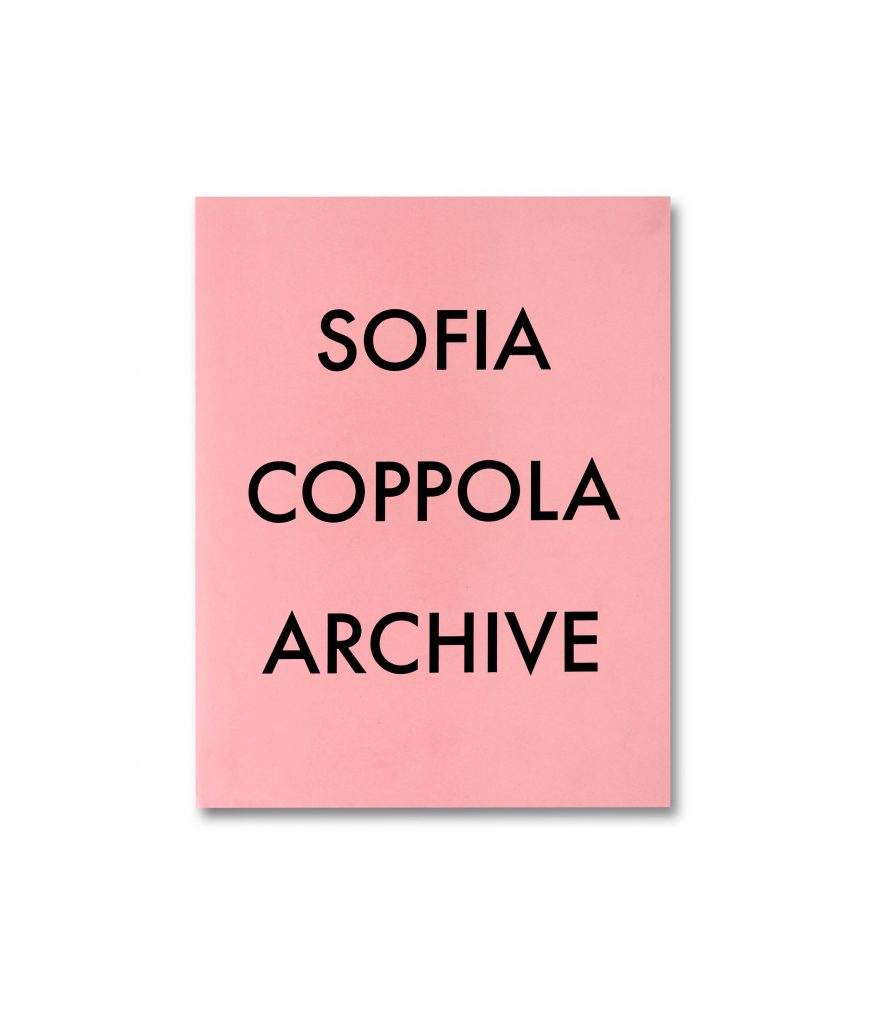
GERMAN VERSION BELOW
Scrapbooks, photo albums, and notebooks are some of my favorite book genres. Emotions, thoughts, ideas, snapshots, correspondence, notes, sometimes put together guided by coincidences. Memories, biographical statements, sketches, drawings, contact sheets, notes, found objects make up this genre. Hodgepodges, literary chambers of curiosities. And by the way: This genre will not be replaced by the productions of artificial intelligence in the foreseeable future. Because it is a direct result of what constitutes life, what constitutes work, relationships, friendships, love, successes, failures, etc.: categories that artificial intelligences will not understand, at least for now.
What connects me with the director Sofia Coppola is the time in which I grew up – she is two and a half weeks older than me – and especially her earlier films, which made a lasting impression on me and remain deeply in my memory. At times I lost sight of her film career, eventually rediscovered it and then I caught up on films again. For me personally, “The Virgin Suicides” from 1999 and “Lost in Translation” from 2003 are among the most important films of the last quarter century. “Priscilla” is currently showing in cinemas, with films such as “Somewhere” (2010), “The Bling Ring” (2013) and “The Beguiled” (2017) in between.

The British publisher Mack Books has now packed Sofia Coppola’s archive between two book covers: „Sofia Coppola Archive 1999-2023“ is the name of the great work that the director herself collected: 21.6 x 28cm in size, a generous 488 pages thick. Her entire film work is reflected in it, full of personal images and texts, surprising insights into the director’s work, including a wonderful interview by the journalist Lynn Hirschberg (editor-at-large at W magazine) with Coppola, an interview that could have been much longer, especially the newer films are covered quite briefly.
“The Virgin Suicides” is the film adaptation of a novel by the writer Jeffrey Eugenides, the fictional, melancholy story about the five daughters of the Lisbon family, who grow up in a lower-middle-class, narrow-minded world in the 70s. Sofia Coppola documents the filming of her feature film debut with a large number of pictures of the actresses and the communication with Jeffrey Eugenides (“I apologize if my most recent letter sounded harsh,” the author writes in one of the letters). Annotated script excerpts (“not in book – gives wrong impression”), Polaroids, reference photos that provided ideas for the look of the film, photo albums that were created during filming, shots of the team during filming – above all the picture of Coppola, who violates the on-set “dress code” norms by wearing a red, bright dress while standing behind the camera. It’s 1999, women in directing jobs are still a huge exception, Sofia Coppola would later become the very first woman nominated for a directing Oscar.
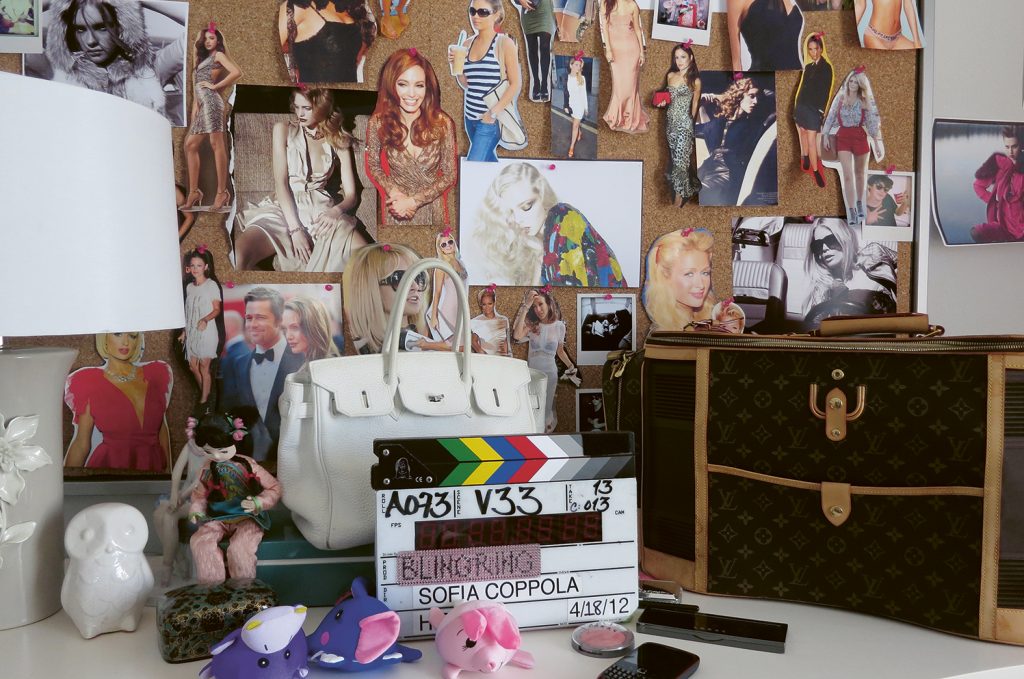
What follows is the chapter about „Lost in Translation“ – and what you immediately notice is: How very different – purely externally – these two films were: colorful, bright, full of sunshine, outside the city vs. dark, inside, at night, metropolitan. This also affects the choice of material for “Lost in Translation”. We learn the story that it wasn’t really clear whether Bill Murray would actually show up on the set in Tokyo. Here, too, there are Polaroids, snapshots from the set, notes, annotated script excerpts, and here again – how exciting is that – snippets, magazine tears, photos that served as a template for the costumes that Scarlett Johansson was supposed to wear in the film. This is so impressive and amazing and I can’t remember ever seeing anything like it before. And finally, as a document of Sofia Coppola’s success: the cover of the New York Times Magazine with the article by Lynn Hirschberg, who conducted the interview with Sofia Coppola here in the book. Title of the interview at the time: “Coppola II. She was the dilettante daughter of a Hollywood legend. Whoever thought she would become one of America’s most promising directors?”
Then the documentary about “Marie Antoinette” from 2006, about which Sofia Coppola writes: “When it came out, a lot of people thought it wasn’t serious enough, or that the music was out of place. But I felt like we made what I had set out to do. It wasn’t a hit when it came out, so it’s been really nice to know that people still watch and enjoy it.” Here, too, it is striking how much the director reinvents herself in her third film: Now it is historical material, the costumes take center stage, the period color. The photos of Kirsten Dunst in the lead role are gorgeous. The film wasn’t a very big success, writes Coppola – and in fact it was the first Coppola film that I hadn’t seen. To this day I’m not really into historical films. But it’s time to catch up on the film, it’s available on various streaming platforms.

Coppola’s other films follow – the chapter about the film „The Bling Ring“ from 2013 is particularly colorful. And at the end the „Priscilla“ chapter: „On this set, I totally felt in my element, doing what I love. I could see moments that felt like past films, but hopefully that’s now my style and all of my experience went into this one. It was a new kind of pressure to do the story of someone who is alive and I always wanted Priscilla to be happy with it, while including what I responded to in her story.”
“Sofia Coppola Archive” is a wonderful, extensive journey of discovery, an exciting, personal and creative insight behind the scenes of the work of a very special filmmaker. The director’s short texts at the beginning of each chapter provide a wonderful review of the respective films. For me it is one of the most beautiful film books of 2023.
Sofia Coppola Archive 1999-2023
Paperback with embossed jacket
21.6 x 28cm, 488 pages
ISBN 978-1-915743-13-8
September 2023
€65 £55 $65
Published by MACK
www.mackbooks.co.uk and @MACK_Books on Instagram
++
GERMAN VERSION
Scrapbooks, Sammelalben, Fotoalben, Notizbücher gehören zu meinen liebsten Buchgenres. Emotionen, Gedanken, Ideen, Schnappschüsse, Briefwechsel, Notizen, manchmal assoziativ zusammengesetzt. Erinnerungen, biografische Äußerungen, Skizzen, Zeichnungen, Kontaktbögen, Zettel, Found Objects machen dieses Genre aus. Sammelsurien, literarische Wunderkammern. Und nebenbei gesagt: Dieses Genre wird auf absehbare Zeit nicht durch die Produktionen künstlicher Intelligenzen ersetzt werden. Weil es ein direktes Resultat dessen ist, was Leben ausmacht, was Arbeit ausmacht, Beziehungen, Freundschaften, Liebe, Erfolge, Misserfolge etc.: Kategorien, die künstliche Intelligenzen zumindest vorerst nicht verstehen werden.
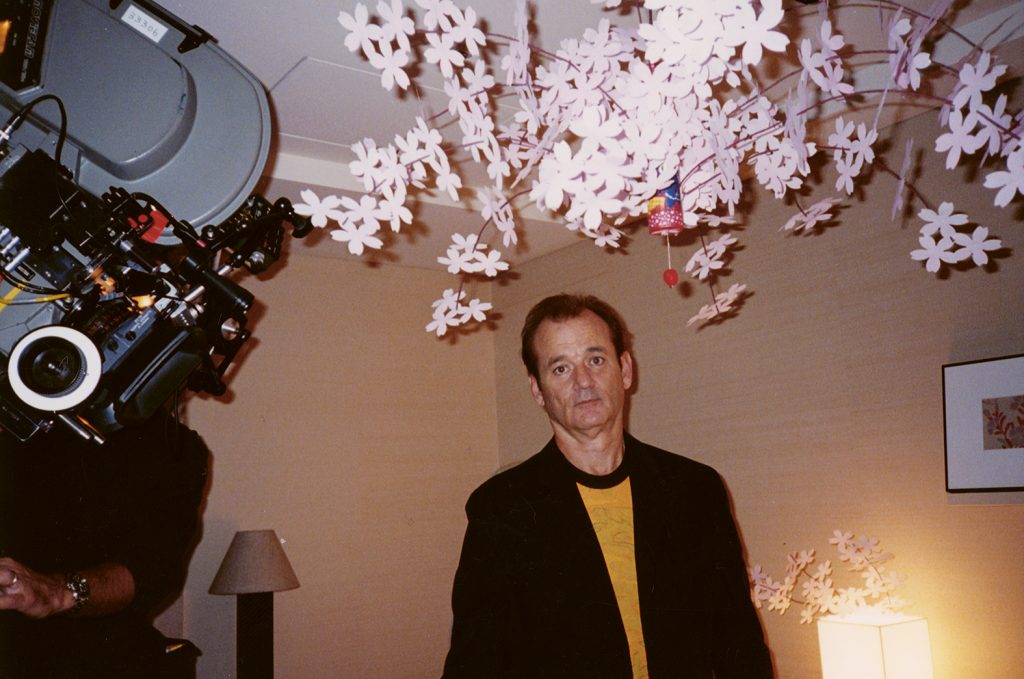
Mit der Regisseurin Sofia Coppola verbindet mich die Zeit, in der ich aufgewachsen bin – sie ist zweieinhalb Wochen älter als ich – und vor allem ihre früheren Filme, die mich nachhaltig beeindruckt haben und die mir zutiefst im Gedächtnis geblieben sind. Zwischendurch habe ich ihre filmische Karriere etwas aus den Augen verloren, schließlich sie für mich wiederentdeckt und dann habe ich Filme auch wieder nachgeholt. „The Virgin Suicides“ aus dem Jahr 1999 und „Lost in Translation“ aus dem Jahr 2003 gehören für mich persönlich jedenfalls zu den wichtigsten Filmen des letzten Vierteljahrhunderts. Derzeit läuft „Priscilla“ in den Kinos, dazwischen liegen Filme wie „Somewhere“ (2010), „The Bling Ring“ (2013) und „The Beguiled“ (2017).
Der britische Verlag Mack Books hat nun Sofia Coppolas Archiv zwischen zwei Buchdeckel gepackt: „Sofia Coppola Archive 1999-2023“ heißt das großartige Werk, das die Regisseurin selbst zusammengesammelt hat: 21.6 x 28cm groß, üppige 488 Seiten dick. Ihr gesamtes filmisches Werk spiegelt sich darin, voller persönlicher Bilder und Texte, überraschenden Einblicken in die Arbeit der Regisseurin, inklusive eines wunderbaren Interviews der Journalistin Lynn Hirschberg (editor-at-large beim W magazine) mit Coppola, ein Interview, das wegen mir auch noch viel länger hätte sein können, gerade die neueren Filme sind doch recht knapp abgehandelt.
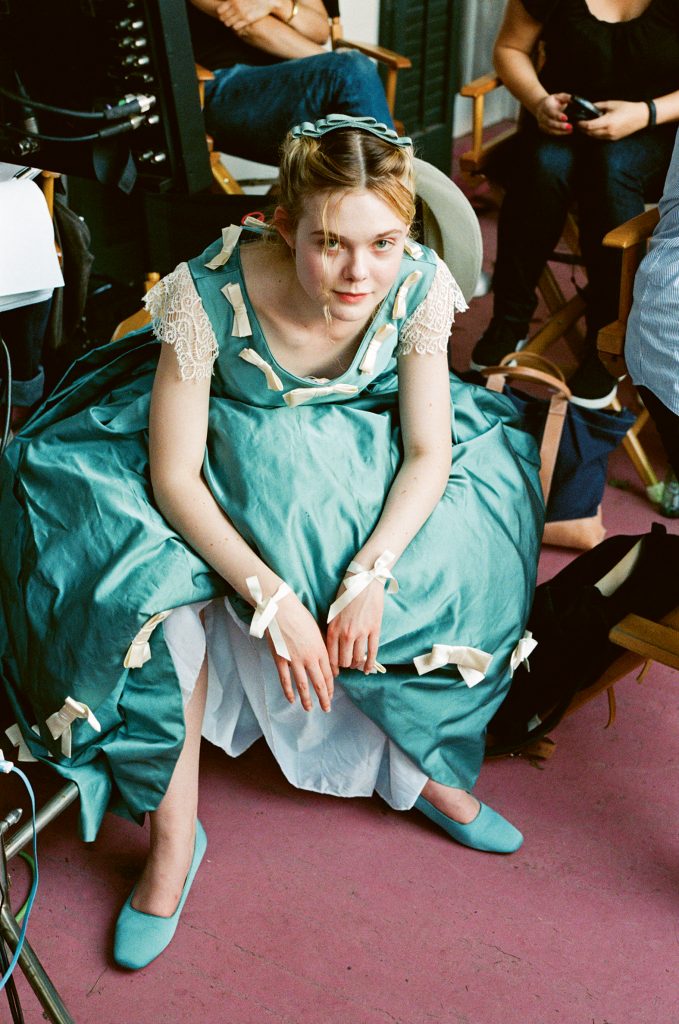
„The Virgin Suicides“ ist die Verfilmung eines Romans des Schriftstellers Jeffrey Eugenides, die fiktionale, schwermütige Geschichte über die fünf Töchter der Familie Lisbon, die in den 70ern in einer kleinbürgerlichen, engstirnigen Welt aufwachsen. Sofia Coppola dokumentiert die Dreharbeiten zu ihrem Spielfilmdebüt mit einer Vielzahl an Bildern der Schauspielerinnen und Schauspieler, mit der Kommunikation mit Jeffrey Eugenides („I apologize if my most recent letter sounded harsh“ schreibt der Autor in einem der Briefe). Kommentierte Drehbuchauszüge („not in book – gives wrong impression“), Polaroids, Referenzfotos, die Ideen zum Look des Films abgaben, Fotoalben, die während des Drehs entstanden, Aufnahmen vom Team bei den Dreharbeiten – allem voran das Bild von Coppola, die gegen die Normen der „Kleiderordnung“ am Set verstößt, weil sie hinter der Kamera stehend ein rotes, leuchtendes Kleid trägt. Wir sind im Jahr 1999, Frauen im Regiejob sind immer noch die Riesenausnahme, Sofia Coppola sollte später die allererste für den Regie-Oscar nominierte Frau werden.
Es folgt die Dokumentation über „Lost in Translation“ – und was einem sofort auffällt ist: Wie sehr gegensätzlich – rein äußerlich – waren diese beiden Filme: Farbig, leuchtend, voller Sonnenschein, draußen, außerhalb der Stadt vs. dunkel, drinnen, nächtlich, großstädtisch. Das wirkt sich auch auf die Materialauswahl zu „Lost in Translation“ aus. Wir erfahren die Geschichte, dass nicht so richtig klar war, ob Bill Murray wirklich am Set in Tokio auftaucht. Auch hier gibt es wieder Polaroids, Schnappschüsse vom Set, Notizen, kommentierte Drehbuchausschnitte, und auch hier wieder – wie spannend ist das – Schnipsel, Zeitschriftenausrisse, Fotos, die als Vorlage für die Kostüme dienten, die Scarlett Johansson im Film tragen sollte. Das ist so beeindruckend und großartig, und ich kann mich nicht erinnern, so etwas in der Art vorher schonmal gesehen zu haben. Und schließlich, als Dokument für den Erfolg von Sofia Coppola: das Cover des New York Times Magazine mit dem Artikel ebenjener Lynn Hirschberg, die hier im Buch das Interview mit Sofia Coppola geführt hat. Titel des Interviews damals: „Coppola II. She was the dilettante daughter of a Hollywood legend. Whoever thought she would become one of America’s most promising directors?”
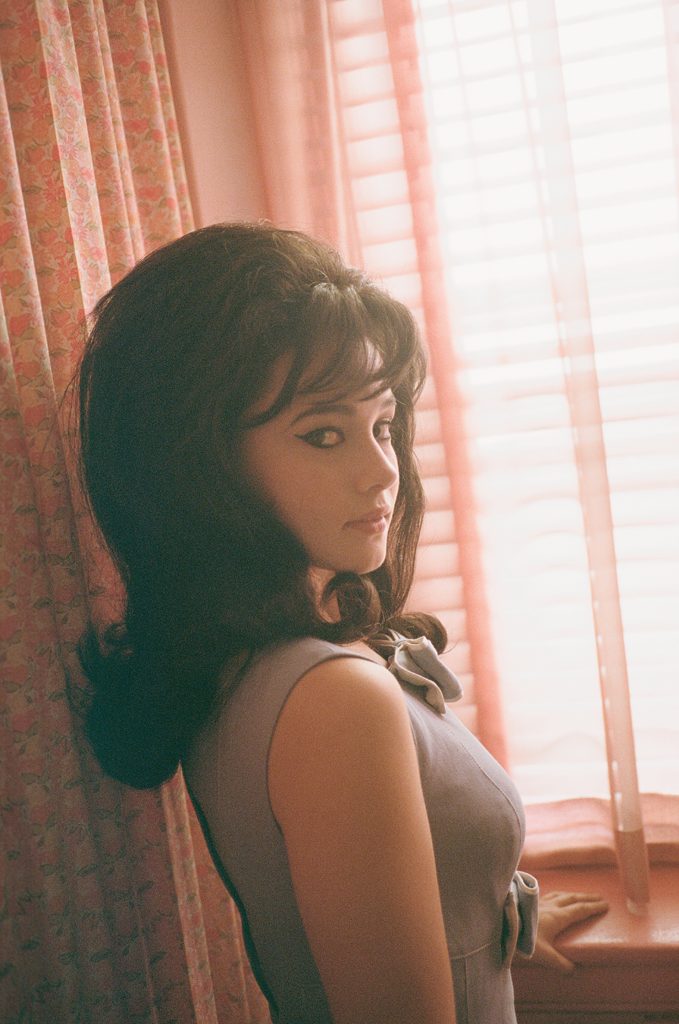
Dann die Dokumentation zu „Marie Antoinette“ aus dem Jahr 2006, über den Sofia Coppola schreibt: „When it came out, a lot of people thought it wasn’t serious enough, or that the music was out of place. But I felt like we made what I had set out to do. It wasn’t a hit when it came out, so it’s been really nice to know that people still watch and enjoy it.” Auch hier fällt wieder auf, wie sehr sich die Regisseurin in ihrem dritten Film neu erfindet: Nun ist es eben ein historischer Stoff, die Kostüme rücken ins Zentrum, das Zeitkolorit. Die Fotos von Kirsten Dunst in der Hauptrolle sind hinreißend. Kein sehr großer Erfolg war der Film, schreibt Coppola – und in der Tat war das damals der erste Coppola-Film, den auch ich nicht gesehen hatte. Bis heute hab ich’s nicht so sehr mit historischen Stoffen. Aber es ist an der Zeit, den Film nachzuholen, er steht auf diversen Streamingplattformen zur Verfügung.
Es folgen Coppolas weitere Filme – besonders bunt ist übrigens das Kapitel über den Film „The Bling Ring“ aus dem Jahr 2013. Und am Ende dann das „Priscilla“-Kapitel: „On this set, I totally felt in my element, doing what I love. I could see moments that felt like past films, but hopefully that’s now my style and all of my experience went into this one. It was a new kind of pressure to do the story of someone who is alive and I always wanted Priscilla to be happy with it, while including what I responded to in her story.”
“Sofia Coppola Archive“ ist eine wundervolle, umfangreiche Entdeckungsreise, ein spannender, persönlicher und kreativer Einblick hinter die Kulissen der Arbeit einer ganz besonderen Filmemacherin. Die kurzen Texte der Regisseurin zu Beginn jeden Kapitels geben einen wunderbaren Rückblick auf die jeweiligen Filme. Es ist für mich eines der schönsten Filmbücher des Jahres 2023.
Sofia Coppola Archive 1999-2023
Paperback with embossed jacket
21.6 x 28cm, 488 pages
ISBN 978-1-915743-13-8
September 2023
€65 £55 $65
Published by MACK
www.mackbooks.co.uk and @MACK_Books on Instagram